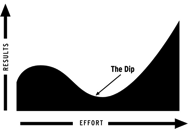 In sales we often feel that if a prospect doesn’t buy from us we’ve somehow failed. Some sales managers reinforce this belief. The truth is that not all prospects are created equally. As with your active clients, some prospects are clearly better than others.
In sales we often feel that if a prospect doesn’t buy from us we’ve somehow failed. Some sales managers reinforce this belief. The truth is that not all prospects are created equally. As with your active clients, some prospects are clearly better than others.
I remember early in my sales career trying to find a way to make my product work for the wrong clients. By the time I was a sales manager, I knew to teach my own staff that when someone asked, “What can I get for $500?” the honest answer was “disappointment.” When you spend your day working prospects that are the wrong fit, it sucks the life out of you. It makes you begin to doubt yourself.
When should you quit? When should you stick it out?
 If the prospect was worth pursuing in the first place, then quitting when you hit “The Dip” (as Seth Godin puts it) just wastes the time you have already invested. Without The Dip however, you’d be easily replaceable and great salespeople wouldn’t make great money. Seth recommends that if you can’t make it through the inevitable dip, don’t start. Smart salespeople learn to be realistic about whether there is actually a potential payout.
If the prospect was worth pursuing in the first place, then quitting when you hit “The Dip” (as Seth Godin puts it) just wastes the time you have already invested. Without The Dip however, you’d be easily replaceable and great salespeople wouldn’t make great money. Seth recommends that if you can’t make it through the inevitable dip, don’t start. Smart salespeople learn to be realistic about whether there is actually a potential payout.
Think carefully before quitting something with great potential, but think just as carefully before starting something with little or no potential.
 Your time is an investment. It pays to evaluate that investment as early in the process as possible. We have a checklist of six key factors to determine if a prospect fits your ideal customer profile. This process is core to what we teach in many of our online courses. You can use this checklist to quickly evaluate if a prospect is worth your time.
Your time is an investment. It pays to evaluate that investment as early in the process as possible. We have a checklist of six key factors to determine if a prospect fits your ideal customer profile. This process is core to what we teach in many of our online courses. You can use this checklist to quickly evaluate if a prospect is worth your time.
- Dollar Potential: Motivated buyers can sometimes find the funds, but you need to determine if their company has the means to invest appropriately in your product and services.
- Access & Credibility: Access to the decision maker is often determined by your credibility. While the dollar potential is often fixed, access and credibility improves when you establish yourself as someone who is trusted and valued.
- Product Fit: Specific product fit is best determined in a needs analysis, but there are plenty of clues to identify a potential fit. Look online for some evidence that your product or service can be of real use to them.
- Value-Added Fit: In some circles value-added has come to mean what the client expects for free. But in a true partnership it signifies that the client places value on what you have to offer beyond simply your core product and price. It could be a simpler process, strategic advice, or providing metrics and tracking.
- Leverage: Leverage refers to how success with this client could open the door for other business opportunities. Could this prospect become a valuable source of referrals and introductions to new decision makers, new business categories, or new divisions at their company?
- Your Personal Reasons: Would this prospect be a good fit for your own unique knowledge and experience? Do you have a passion for this type of client?
Consider each area of the ideal customer profile to focus your efforts on working with the best prospects. Determine early on whether you should stick it out during the dip, or move your investment of time to a better prospect.
Want to learn more about determining the ideal customer? Check out Mike Anderson’s “Sorry Dude, She’s Just Not That Into You” or download the summary below.



